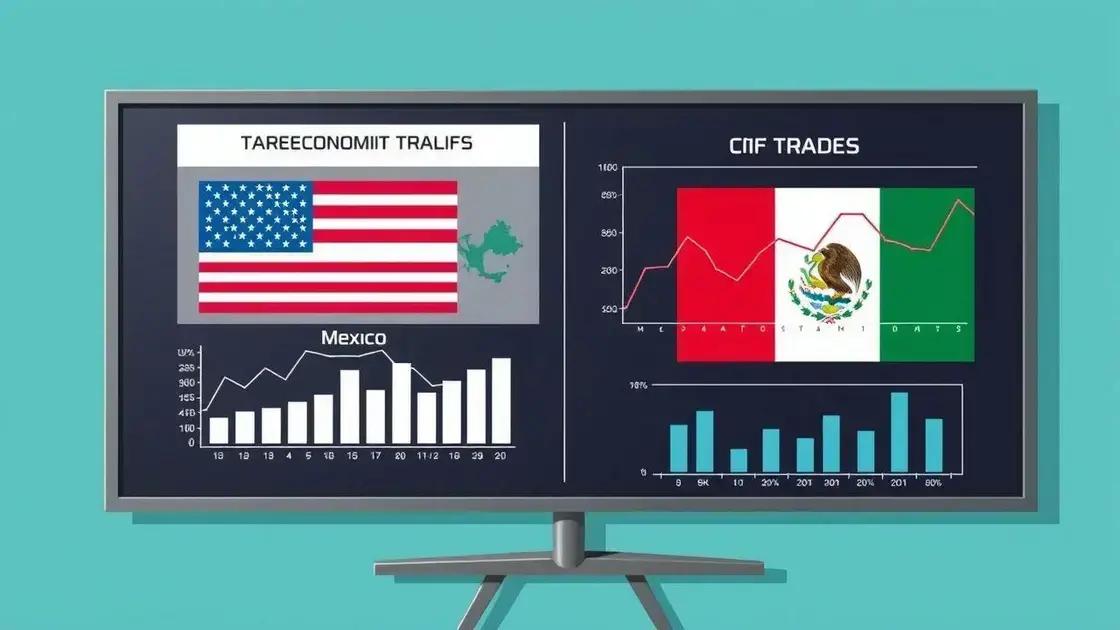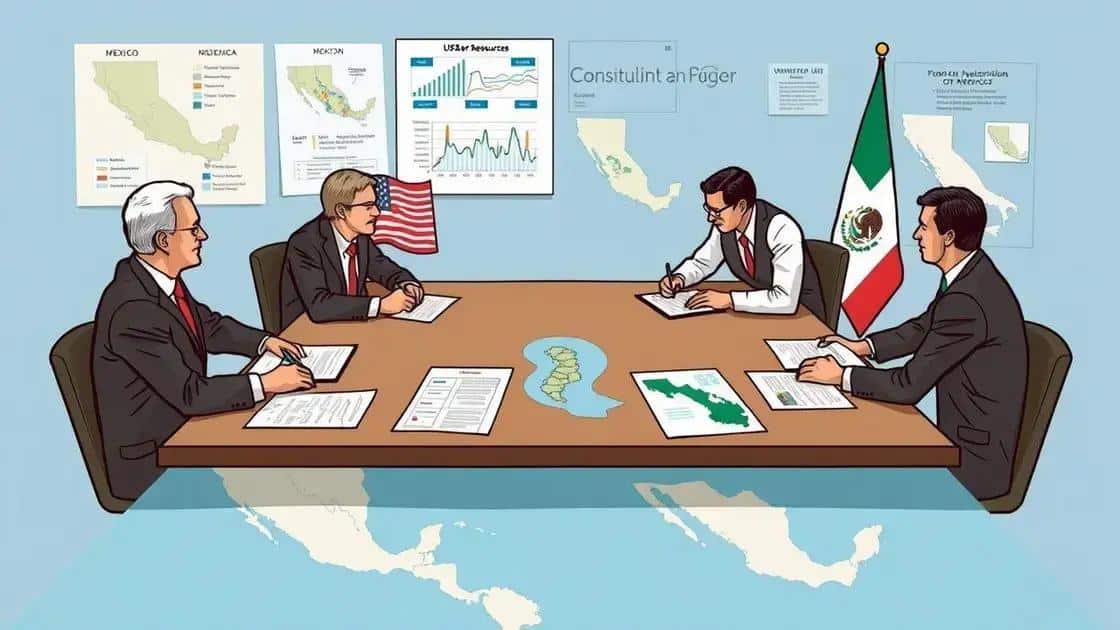Trump escalates tariff threats in ongoing Mexico water dispute

Anúncios
Trump escalates tariff threats in the ongoing Mexico water dispute, creating significant impacts on trade relations, diplomacy, and future negotiations over shared water resources.
Trump escalates tariff threats in ongoing Mexico water dispute. This situation is more than just a political strategy; it has real implications for trade and neighboring communities. Are you wondering how this conflict will unfold?
Overview of the water dispute between the US and Mexico
The water dispute between the US and Mexico is a complex issue impacting both countries. It mainly centers around the allocation and management of shared water resources from the Colorado River. Understanding this problem is crucial, as it affects farmers, residents, and international relations.
Background of the dispute
The roots of the conflict go back many years, with treaties originally signed to define water rights. The 1944 Water Treaty was intended to resolve these issues, ensuring both countries receive a fair share of water. However, changing climate conditions and increasing populations have intensified the competition.
Key Issues
Several key issues fuel the conflict:
- Water scarcity: Both countries face significant droughts.
- Agricultural demands: Farmers in both nations require substantial water for crops.
- Political tensions: Different political priorities sometimes complicate negotiations.
- Environmental concerns: Ecosystems are at risk due to over-extraction.
As both nations struggle to meet their water needs, the stakes are high for communities reliant on these precious resources. Cooperation is essential to avoid further escalation of tensions.
In recent years, both governments have attempted to negotiate new agreements to address the growing concerns. These discussions emphasize the importance of sustainable management practices to ensure future water availability.
Ultimately, finding common ground and fostering collaboration will be vital for resolving the water dispute effectively, allowing both nations to thrive economically and socially.
Analysis of Trump’s tariff threats

Trump’s tariff threats have made headlines as tensions between the US and Mexico rise over the ongoing water dispute. This analysis examines the potential consequences and motivations behind these threats.
Understanding Tariff Threats
Tariffs are taxes imposed on imported goods, designed to protect domestic industries. Trump’s approach to tariffs has been aggressive, particularly regarding Mexico. By applying tariffs, the administration hopes to leverage economic pressure to influence negotiations over shared resources.
Potential Impacts
The ramifications of these tariff threats are significant:
- Economic strain: Tariffs could lead to increased costs for consumers in both countries.
- Market response: Stock markets tend to react negatively to uncertainty caused by trade threats.
- Political backlash: Domestic opposition may arise if tariffs harm American businesses or workers.
- International relations: Tariffs can sour diplomatic ties, affecting more than just water negotiations.
As these dynamics unfold, it’s important to monitor how both governments respond. Trump’s threats might be a tactic to gain leverage rather than a firm commitment to impose punitive measures. Mexico’s government has reacted cautiously, signaling a desire to resolve matters diplomatically.
Trade experts are watching closely. They warn that the escalation of tariff threats could disrupt not only negotiations about water but also broader trade relations. In times of crisis, both nations need to cooperate to find solutions.
Impacts on trade relations and diplomacy
Impacts on trade relations and diplomacy are significant when it comes to the ongoing water dispute between the US and Mexico. The tension over shared resources can complicate otherwise friendly diplomatic ties.
Effects on Trade
Trade relations can suffer as tariffs and threats create uncertainty. The economic interdependence between the US and Mexico means that any disruption can have a ripple effect. For example, businesses in both countries may face higher costs, which could lead to:
- Increased prices: Consumers may notice higher prices for goods.
- Supply chain disruptions: Companies may struggle to maintain efficient operations.
- Job losses: Industries dependent on smooth trade may face layoffs.
- Reduced investment: Increased risk may deter foreign investment.
The implications extend beyond economics. When trade is threatened, it can sour diplomatic efforts as both nations position themselves defensively. Diplomatic negotiations may falter as each side focuses on protecting its own interests.
International Response
Other countries are also watching closely. The situation can influence broader regional politics, encouraging alliances or tensions in trade discussions. Both the US and Mexico must navigate these waters carefully to maintain relationships with other nations.
As discussions around trade continue, it’s vital for leaders to understand the broader consequences. Clear communication and cooperative solutions are necessary to foster a productive dialogue that benefits both parties. Only through collaboration can they hope to resolve this water dispute while preserving trade relations.
Future implications for US-Mexico negotiations

The future implications for US-Mexico negotiations are significant as the water dispute continues. Both countries face challenges that could shape their diplomatic and trade relations for years to come.
Long-term Cooperation
To move forward, it is vital for both nations to build a framework for ongoing cooperation. Effective negotiations may require:
- Shared water management: Both countries must agree on sustainable practices to benefit their populations.
- Regular dialogue: Establishing routine communication can ease misunderstandings.
- Joint projects: Collaborative efforts could enhance trust and reduce regional tensions.
- Flexible agreements: Adaptable agreements will help them respond to future challenges like climate change.
As both nations navigate these waters, they must consider how their decisions today will affect future generations. Ensuring that natural resources are preserved is crucial for economic and environmental stability.
Political Dynamics
Political factors play a significant role in negotiations. Changes in administration on either side can shift priorities and approaches. The upcoming elections in both countries may influence how the leaders handle this issue. It will be essential for both sides to remain committed, regardless of political changes.
Moreover, public opinion will play a crucial role. Citizens from both nations are affected by the outcomes, making it imperative for leaders to consider their viewpoints in negotiations. Addressing concerns from stakeholders, including farmers and consumers, will foster a sense of ownership and support for any agreements made.
In summary, the future of US-Mexico negotiations largely depends on constructive dialogue, shared goals, and public buy-in. By prioritizing collaboration, both nations can pave the way for a more harmonious and sustainable future.
FAQ – Frequently Asked Questions about the US-Mexico Water Dispute
What are the main issues in the US-Mexico water dispute?
The main issues include water scarcity, agricultural demands, and environmental concerns affecting both countries.
How do tariff threats impact trade relations between the US and Mexico?
Tariff threats can increase costs for consumers and disrupt supply chains, leading to strained trade relations.
What role does public opinion play in negotiations?
Public opinion is crucial as citizens’ support can influence leaders to prioritize cooperation and effective agreements.
What are the long-term implications of the water dispute?
Long-term implications include the need for sustainable water management practices and ongoing collaboration between both nations.






